Your kitchen island isn’t just a functional workspace—it’s the visual and social centerpiece of your entire kitchen. As interior designer Carly Reynolds notes, “Whether a home chef or a home flipper, adding or updating a kitchen island has advantages” that extend far beyond mere utility build.com. Today’s kitchen islands have evolved from simple prep zones into design statements that reflect your personal style while enhancing daily living.
The kitchen island has become the heartbeat of modern homes, where family gatherings, impromptu dinners, and morning coffee rituals unfold. According to Martha Stewart’s design team, “The kitchen island is more than a functional workhorse—it’s the visual and social centerpiece of the room” marthastewart.com. This dual role as both practical workspace and design focal point makes thoughtful styling essential for creating a cohesive, inviting kitchen environment.

Pro Tip: Before decorating, assess your island’s primary function—cooking, dining, or display? This determines whether you should prioritize functional accessories (like cutting boards and utensils) or purely aesthetic elements (like sculptural vases or curated displays).
1. Integrated Chopping Block and Knife Holder
This dual-function feature transforms your island from a passive surface into an active culinary station. The seamless integration of a cutting board and knife storage creates a streamlined look while keeping essential tools within arm’s reach during meal prep. Many modern designs use end-grain wood blocks that double as decorative elements when not in use.
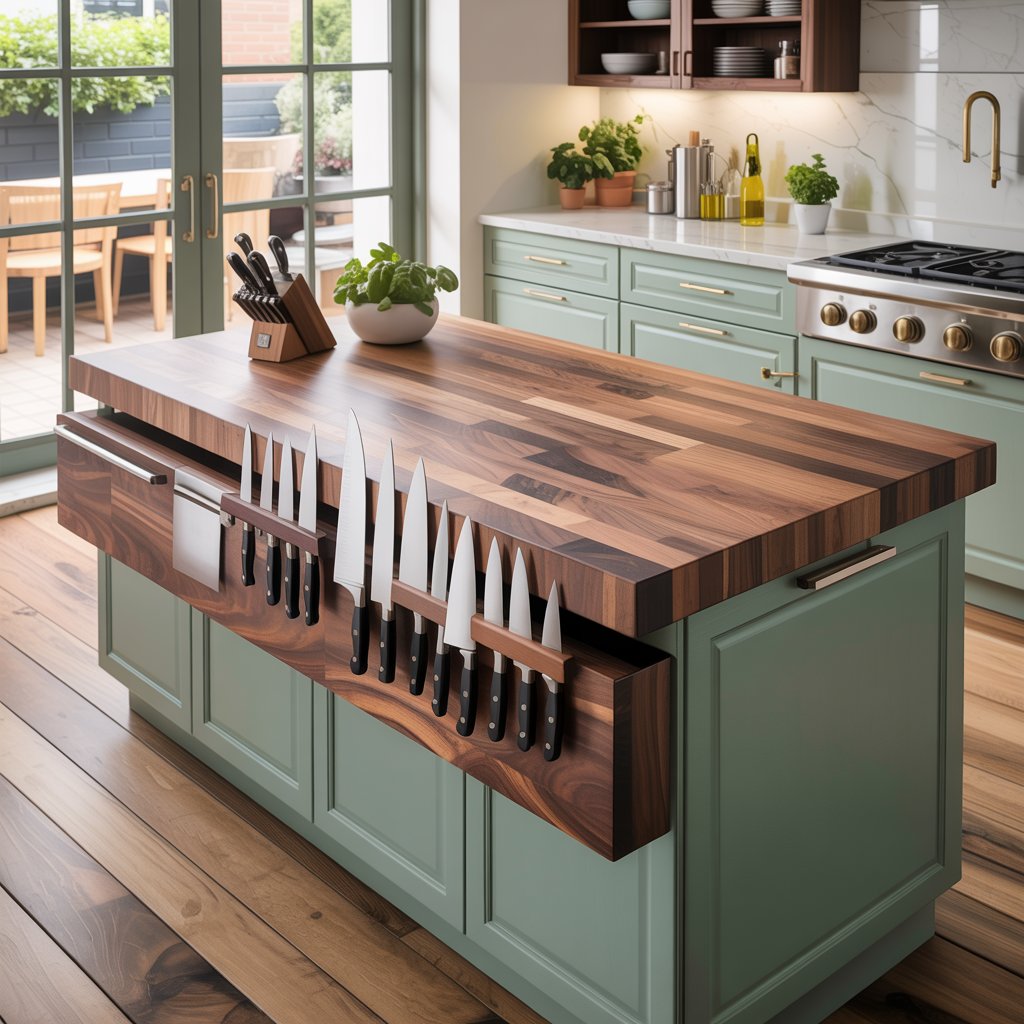
Homeowners increasingly prefer this solution for its practicality and aesthetic appeal. As highlighted by Tony Wallis Homes, “With some creativity—and the help of a talented designer and cabinetmaker—you can equip your island with all kinds of handy bells and whistles” tonywallishomesblog.com. This approach eliminates the need for separate knife blocks and cutting boards cluttering your counter space.
2. Waterfall Edge Countertop
A waterfall edge creates drama by extending the countertop material down the sides of your island, forming a continuous, seamless surface. This design element adds architectural interest while making the island feel substantial and grounded in the space. The uninterrupted flow from top to sides creates visual cohesion that elevates the entire kitchen.
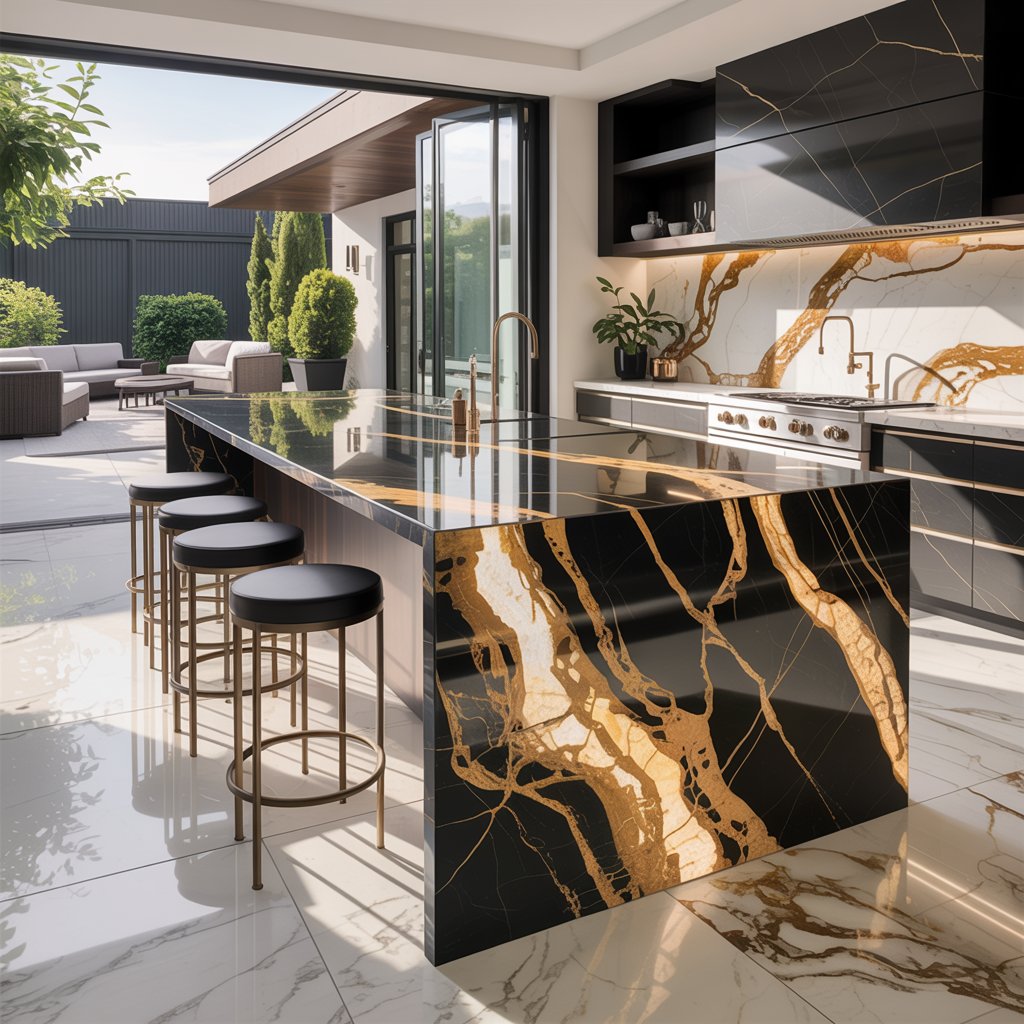
This trend has gained significant popularity in contemporary kitchen design. According to Livingetc, “A waterfall kitchen island with extra seating on the right side” creates a luxury feel that transforms ordinary spaces livingetc.com. The dramatic visual impact works particularly well with stone, quartz, or engineered surfaces that showcase natural patterns and colors.
3. Fluted Island Front
Fluted detailing on the island’s front face introduces texture and dimension without overwhelming the space. This design feature creates visual interest through shadow play and subtle pattern, adding sophistication to an otherwise plain surface. The vertical lines also create the illusion of height, making lower ceilings appear more spacious.
This technique has become increasingly popular among designers seeking refined elegance. As Livingetc notes, “Be different with a fluted kitchen island” for a look that feels both contemporary and timeless livingetc.com. The fluted pattern works beautifully with both painted and natural wood finishes, adapting to various kitchen styles.
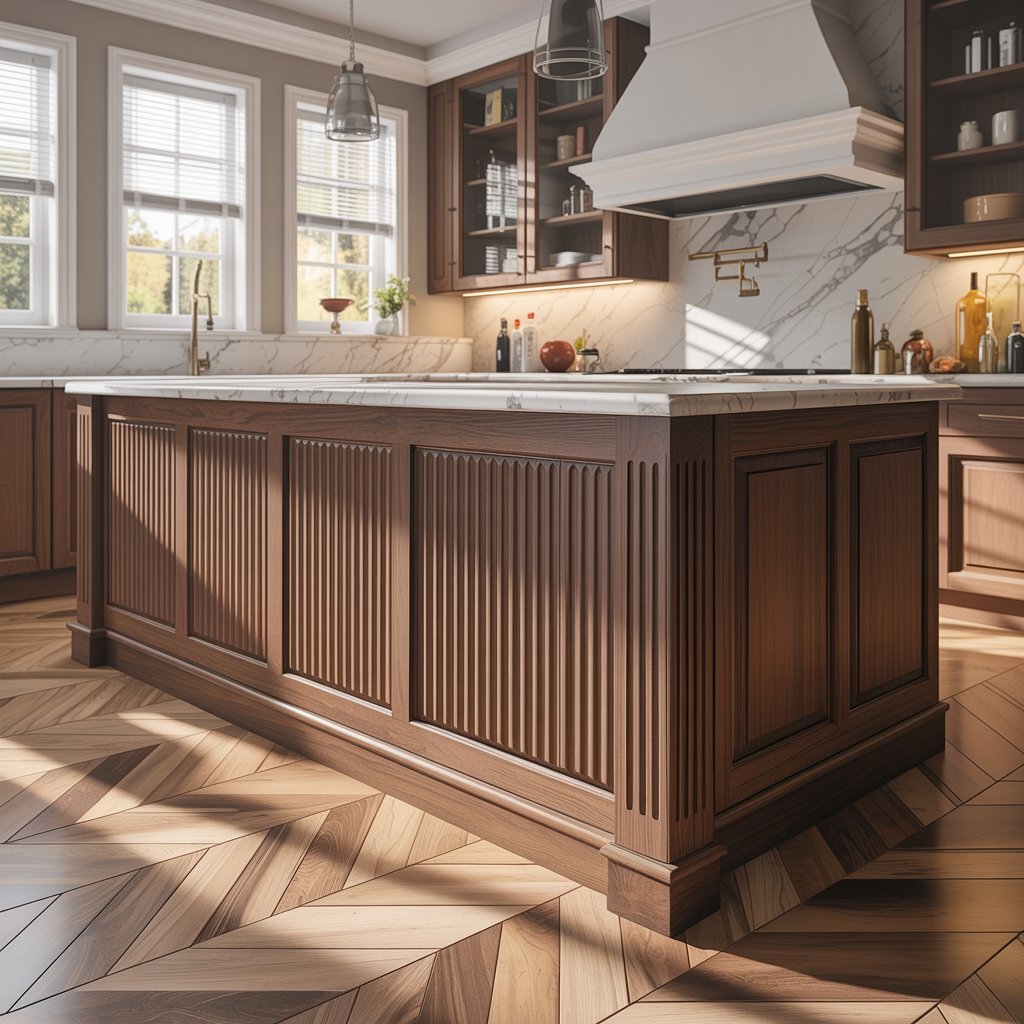
Material Comparison for Fluted Details:
| Material | Best For | Maintenance | Cost |
|---|---|---|---|
| Wood | Traditional kitchens | Requires occasional refinishing | $$$$ |
| Painted MDF | Contemporary spaces | Wipe clean with damp cloth | $$ |
| Thermofoil | High-moisture areas | Resists stains and scratches | $$$ |
| Metal | Industrial designs | Wipe with microfiber cloth | $$$$ |
4. Statement Pendant Lighting
Strategic lighting above your island creates both functional illumination and design impact. A single oversized pendant or a cluster of smaller fixtures draws attention to the island while providing task lighting for food preparation. The right lighting can transform your island from a purely functional element into a design showpiece.
This approach has become essential in modern kitchen design. Kitchen Cabinet Kings emphasizes that “kitchen island ideas” should include “strategic lighting” to “upgrade your space” kitchencabinetkings.com. The key is selecting fixtures that complement your island’s scale—larger islands typically require multiple pendants while smaller ones work well with a single dramatic piece.

Lighting Pro Tip: Position pendant lights 30-36 inches above the island surface for optimal illumination. For multiple pendants, space them 24-30 inches apart and centered over the island length.
5. Decorative Storage Solutions
Open shelving or glass-front cabinets on the island’s perimeter create display opportunities while keeping essentials accessible. This design approach transforms storage into styling opportunities, allowing you to showcase beautiful cookware, dinnerware, or decorative objects. The curated display adds personality while maintaining functionality.

The trend toward visible storage has gained momentum as homeowners seek more personalized kitchens. Build.com highlights that decorative storage “has advantages” beyond mere organization build.com. The key is to maintain visual balance—display items should complement rather than clutter the space, with empty space as important as the displayed objects.
6. Color Blocking with Contrasting Finishes
Painting the island a different color than your perimeter cabinets creates a bold visual statement. This technique works especially well in monochromatic kitchens where the island becomes the focal point. The contrast can range from subtle (different shades of the same color) to dramatic (complementary colors).

Kitchen Cabinet Kings features numerous examples where “color blocking” transforms ordinary islands into design highlights kitchencabinetkings.com. This approach allows homeowners to experiment with color without committing to painting all their cabinets, making it ideal for renters or those hesitant about bold color choices.
7. Live Edge Wood Top
A live edge countertop showcases the natural beauty of wood by preserving the tree’s organic edges. This design element brings warmth and authenticity to modern kitchens while creating a unique focal point. Each piece is one-of-a-kind, ensuring your island becomes a conversation piece.

The trend toward natural materials has made live edge designs increasingly popular. Livingetc highlights how “be bold with a boulder” approach creates distinctive kitchen features livingetc.com. While beautiful, live edge surfaces require more maintenance than standard countertops and work best as secondary food prep areas rather than primary workspaces.
8. Integrated Seating with Custom Stools
Built-in seating that flows seamlessly with the island design creates a cohesive look while maximizing space. Custom stools that match the island’s material and height create visual harmony. This approach transforms the island from a work zone into a social hub for casual dining and conversation.
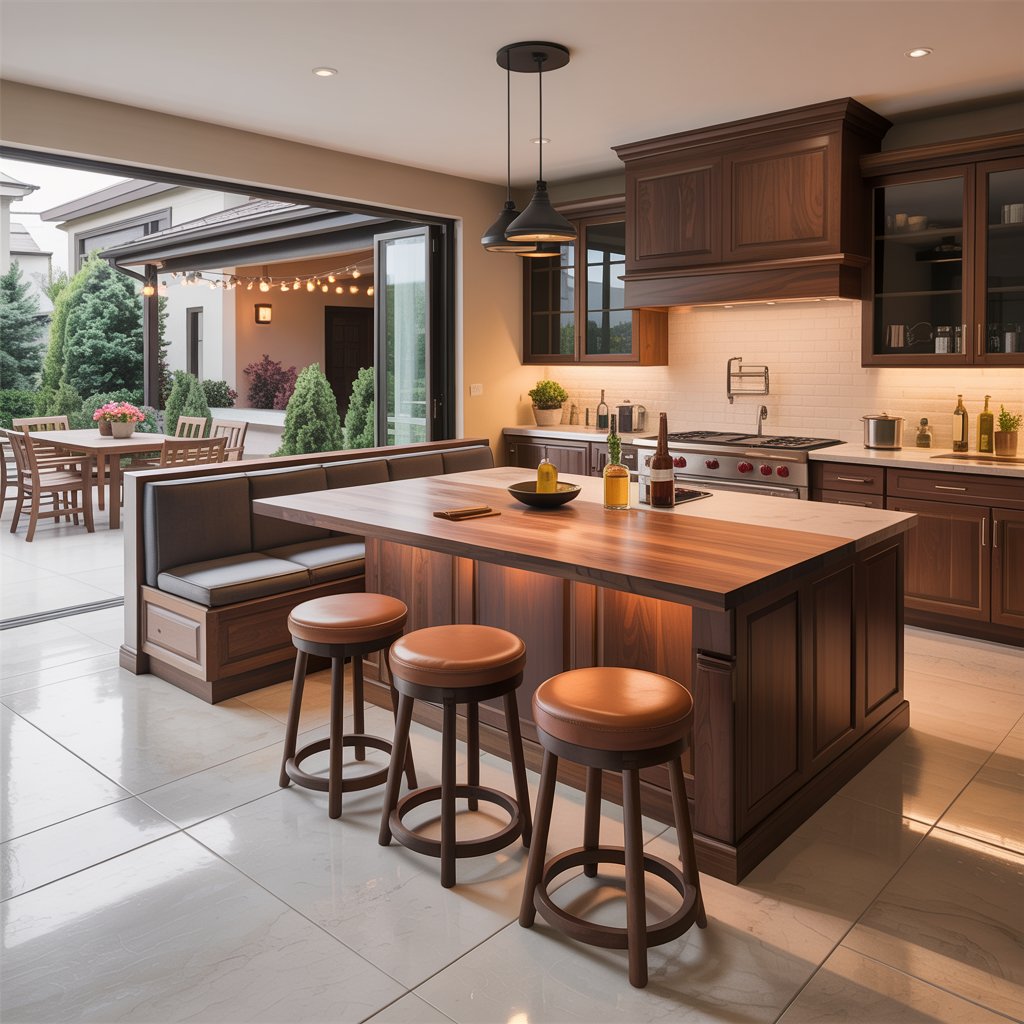
Tony Wallis Homes emphasizes that integrated seating is “among homeowners who are remodeling or building their kitchens from scratch” tonywallishomesblog.com. The key is ensuring adequate knee space (at least 12 inches) and counter height (typically 36 inches) for comfortable seating.
9. Built-In Wine Storage
Refrigerated wine storage or open wine racks integrated into the island provide both functionality and visual interest. This feature transforms the island into an entertainment center while keeping beverages conveniently accessible during gatherings. The display of wine bottles creates a dynamic visual element.

Kitchen Cabinet Kings showcases multiple examples where “built-in wine storage” enhances kitchen island functionality kitchencabinetkings.com. The design works best when the wine storage aligns with the kitchen’s overall style—stainless steel units for modern kitchens, wood racks for traditional spaces.
10. Mini Herb Garden Display
A small, integrated herb garden brings life and functionality to your island. This can range from a simple tray of potted herbs to a built-in planter with drainage. The greenery adds color and freshness while providing convenient access to cooking ingredients.
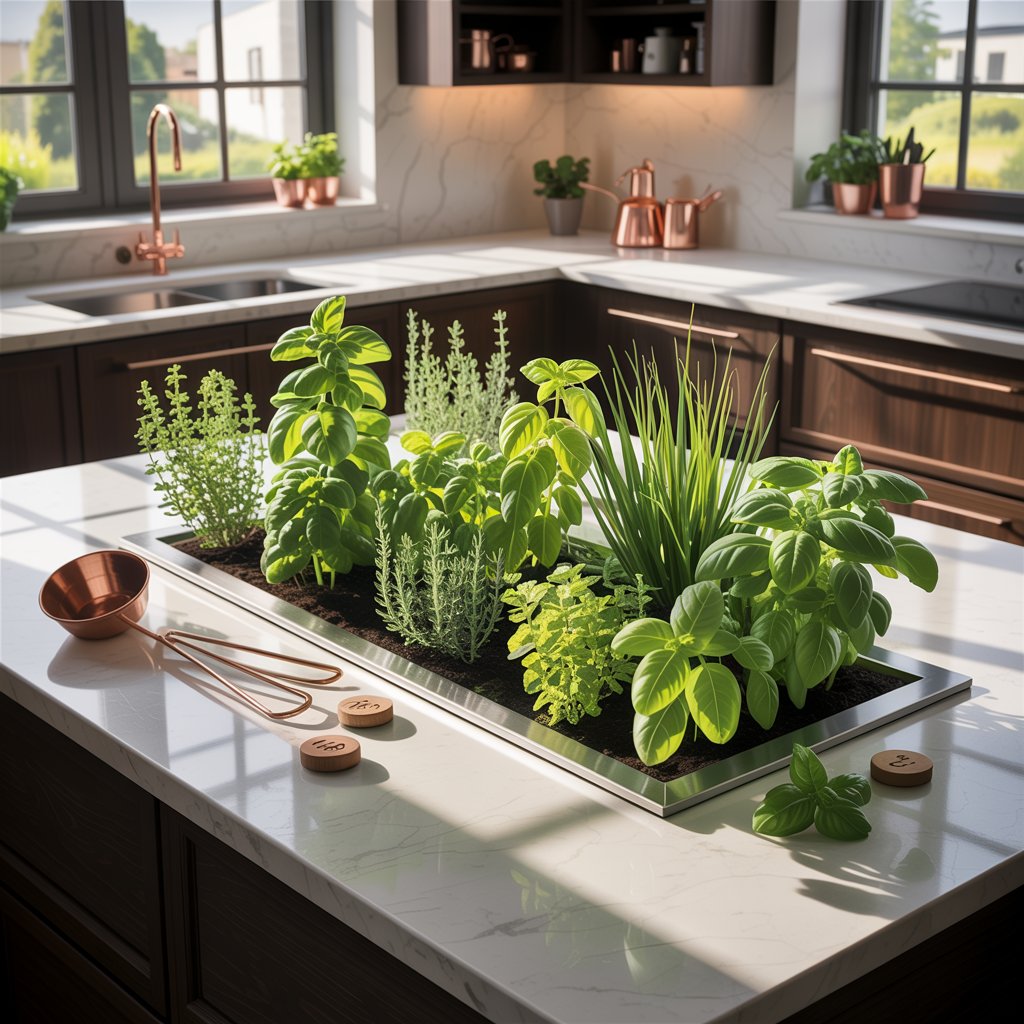
Martha Stewart’s team recommends this approach as part of “kitchen island décor” that “elevate your entire space” marthastewart.com. Position the herb garden near natural light sources and choose hardy varieties like basil, thyme, and mint that thrive in kitchen environments.
11. Statement Backsplash Extension
Extending your backsplash material around the island creates visual cohesion while adding design interest. This technique works particularly well with patterned tile, stone, or metal backsplashes that become design features. The continuity ties the island to the main kitchen area.

Livingetc features kitchens where “statement backsplash” designs extend to the island for a unified look livingetc.com. The key is selecting a material that complements rather than competes with the island’s countertop and cabinetry.
12. Mix of Materials for Texture
Combining different materials on your island creates visual interest through texture contrast. This might include wood with stone, metal with wood, or concrete with glass. The juxtaposition of materials adds depth and sophistication to the design.
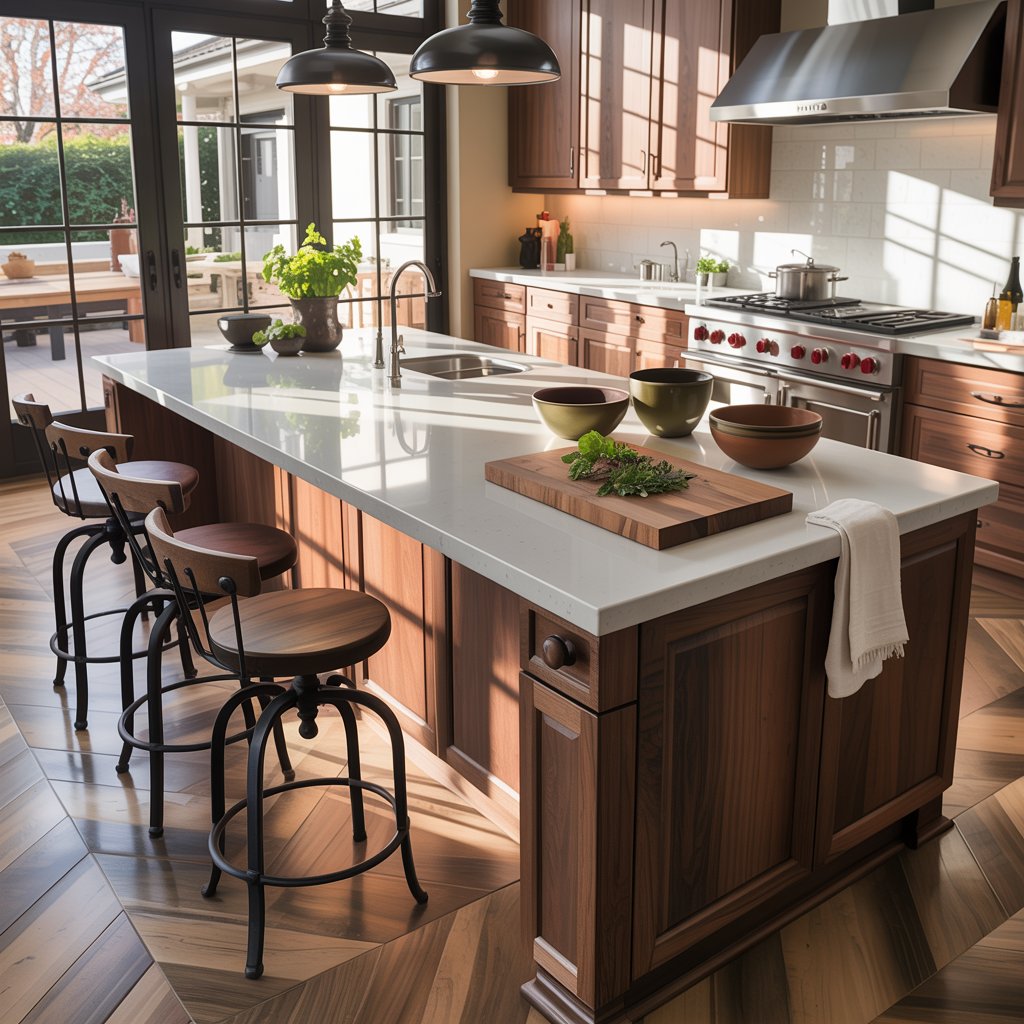
Build.com highlights how mixing materials “has advantages” for creating personalized kitchen designs build.com. The trick is to maintain balance—too many materials can create visual chaos, while one or two complementary textures create harmony.
13. Curated Object Display
Strategic placement of decorative objects transforms your island into a design focal point. This might include a sculptural bowl, vintage kitchen tools, or a collection of pottery. The key is intentional curation rather than random clutter.
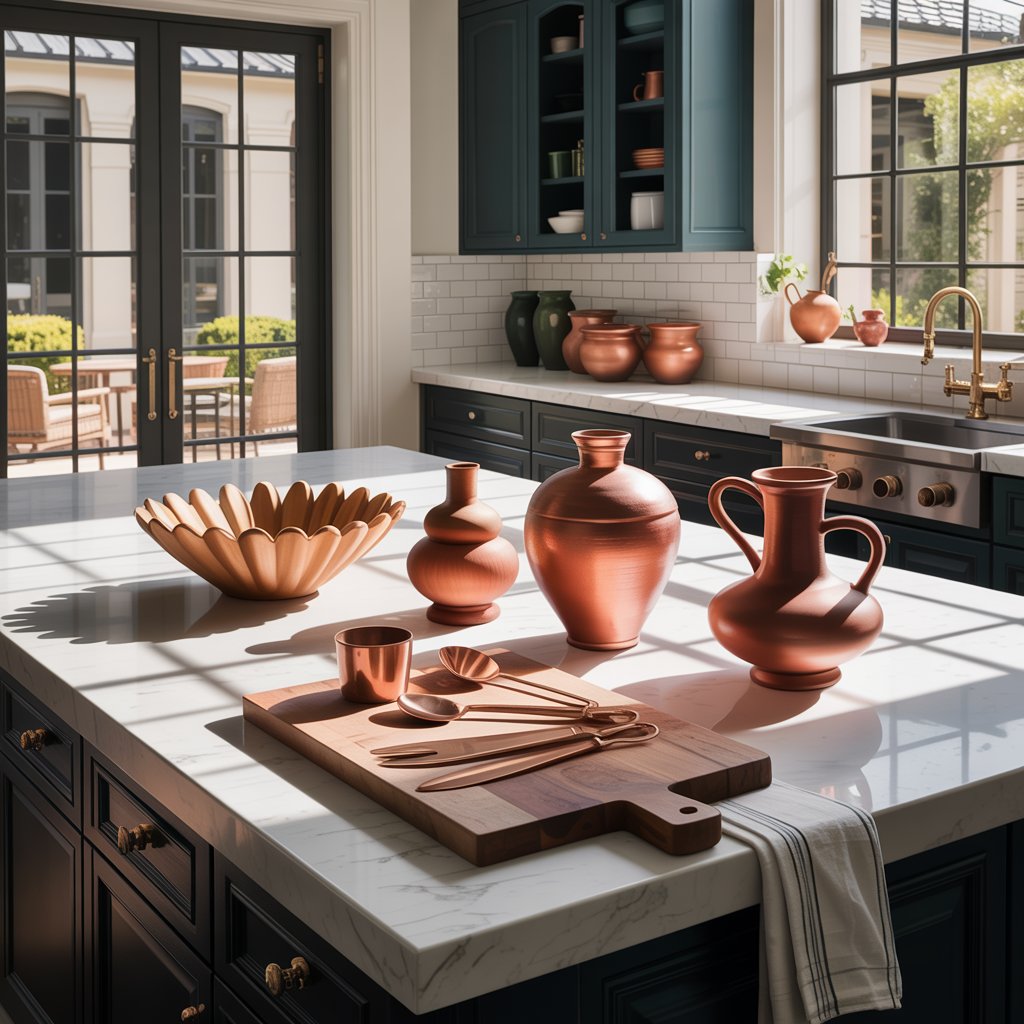
Martha Stewart’s design team emphasizes that “thoughtful kitchen island décor can elevate your entire space” marthastewart.com. Rotate displays seasonally to keep the look fresh—spring flowers, summer fruits, or fall gourds can create temporary, beautiful arrangements.
14. Integrated Charging Station
A hidden charging station with built-in outlets and USB ports keeps devices powered without visible cords. This practical feature transforms the island into a multi-functional hub for both cooking and technology. The charging station can be recessed into the island or hidden behind a panel.

This feature has become essential in modern kitchens where the island serves as both workspace and social hub. Kitchen Cabinet Kings features multiple examples of how integrated technology solutions “upgrade your space” kitchencabinetkings.com. Position the charging station on the side facing living areas for easy access while cooking.
15. Multi-Level Design for Zoning
Creating different heights on your island establishes functional zones within a single piece. A raised section might serve as a dining area while a lower section functions as a prep space. This design solution maximizes the island’s utility while creating visual interest.
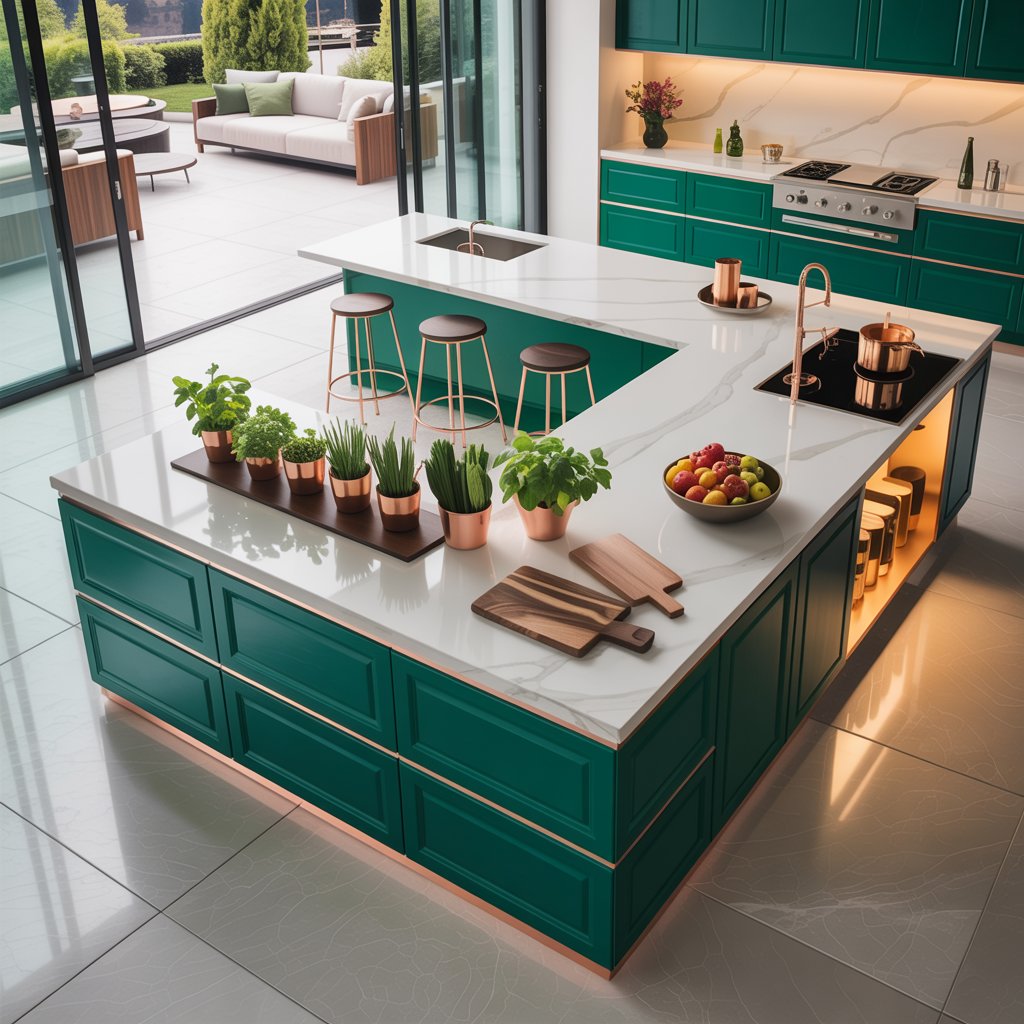
Kitchen Cabinet Kings highlights how “multi-level design” approaches provide “kitchen island ideas” that enhance both form and function kitchencabinetkings.com. The height difference should be at least 6 inches to create distinct zones while maintaining visual flow between them.
Final Thoughts: Creating Your Signature Kitchen Island
Your kitchen island should reflect both your lifestyle and design sensibilities, serving as the heart of your kitchen where function meets beauty. As designer Faiza Saqib notes, “kitchen island ideas” should “feel pitch perfect” for your specific space and needs livingetc.com. The most successful islands balance practicality with personality, creating spaces that work hard while looking beautiful.
When selecting decor elements, consider how each choice supports your daily routines while expressing your personal style. The best kitchen island designs aren’t just visually appealing—they enhance how you live, cook, and gather in your home. Whether you opt for integrated storage, statement lighting, or a combination of textures, your island can become the design highlight that transforms your entire kitchen into a welcoming, functional space that you’ll love for years to come.
